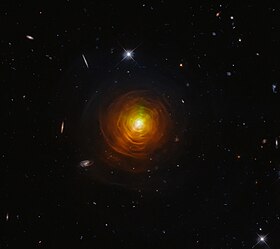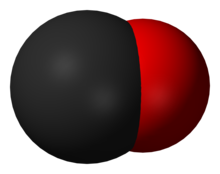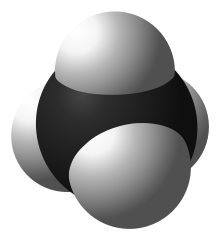List of interstellar and circumstellar molecules
This is a list of molecules that have been detected in the interstellar medium and circumstellar envelopes, grouped by the number of component atoms. The chemical formula is listed for each detected compound, along with any ionized form that has also been observed.
Background
The molecules listed below were detected through
Sometimes a transition can involve more than one of these types of energy level e.g.
The spectrum of a particular molecule is governed by the
Detection of a new interstellar or circumstellar molecule requires identifying a suitable astronomical object where it is likely to be present, then observing it with a
The inventory of detected molecules is highly biased towards certain types which are easier to detect: e.g. radio astronomy is most sensitive to small linear molecules with a high

One of the richest sources for detecting interstellar molecules is
The discipline of
Molecules
The following tables list molecules that have been detected in the interstellar medium or circumstellar matter, grouped by the number of component
Most of the molecules detected so far are

Diatomic (43)
Triatomic (44)

Four atoms (30)
| Molecule | Designation | Mass | Ions |
|---|---|---|---|
| CH3 | Methyl radical[92] | 15 | CH+3[93] |
| l-C3H | Propynylidyne[94] | 37 | l-C3H+[95] |
| c-C3H | Cyclopropynylidyne[96] | 37 | — |
| C3N | Cyanoethynyl[97] | 50 | C3N−[98] |
| C3O | Tricarbon monoxide[94] | 52 | — |
| C3S | Tricarbon sulfide[63]
|
68 | — |
| — | Hydronium | 19 | H3O+[99] |
| C2H2 | Acetylene[100] | 26 | — |
| H2CN | amidogen[101]
|
28 | H2CN+[26] |
| H2NC | Aminocarbyne[102] | 28 | — |
| H2CO | Formaldehyde[91] | 30 | — |
| H2CS | Thioformaldehyde[103] | 46 | — |
| HCCN | —[104] | 39 | — |
| HCCO | Ketenyl[105] | 41 | — |
| — | Protonated hydrogen cyanide
|
28 | HCNH+[77]
|
| — | Protonated carbon dioxide
|
45 | HOCO+[106] |
| HCNO | Fulminic acid[107] | 43 | — |
| HOCN | Cyanic acid[108] | 43 | — |
| CNCN | Isocyanogen[109] | 52 | — |
| HOOH | Hydrogen peroxide[110] | 34 | — |
| HNCO | Isocyanic acid[87] | 43 | — |
| HNCN | Cyanomidyl radical[111] | 41 | — |
| HNCS | Isothiocyanic acid[112] | 59 | — |
| NH3 | Ammonia[113] | 17 | — |
| HSCN | Thiocyanic acid[114] | 59 | — |
| SiC3 | Silicon tricarbide[34] | 64 | — |
| HMgNC | Hydromagnesium isocyanide[115] | 51.3 | — |
| HNO2 | Nitrous acid[116] | 47 | — |

Five atoms (20)
| Molecule | Designation | Mass | Ions |
|---|---|---|---|
| — | Ammonium ion | 18 | NH+ 4[118][119] |
| CH4 | Methane[120] | 16 | — |
| CH3O | Methoxy radical[121]
|
31 | — |
| c-C3H2 | Cyclopropenylidene[27][122][123] | 38 | — |
| l-H2C3 | Propadienylidene[123] | 38 | — |
| H2CCN | Cyanomethyl[124] | 40 | — |
| H2C2O | Ketene[87] | 42 | — |
| H2CNH | Methylenimine[125] | 29 | — |
| HNCNH | Carbodiimide[126] | 42 | — |
| — | Protonated formaldehyde
|
31 | H2COH+[127] |
| C4H | Butadiynyl[34] | 49 | C4H−[128] |
| HC3N | Cyanoacetylene[27][77][129][130] | 51 | — |
| HCC-NC | Isocyanoacetylene[131] | 51 | — |
| HCOOH | Formic acid[132][129] | 46 | — |
| NH2CN | Cyanamide[133][134] | 42 | — |
| NH2OH | Hydroxylamine[135] | 37 | — |
| — | Protonated cyanogen
|
53 | NCCNH+[136] |
| HC(O)CN | Cyanoformaldehyde[137] | 55 | — |
| C5 | Linear C5[138] | 60 | — |
| SiC4 | Silicon-carbide cluster[53] | 92 | — |
| SiH4 | Silane[139] | 32 | — |
Six atoms (16)
| Molecule | Designation | Mass | Ions |
|---|---|---|---|
| c-H2C3O | Cyclopropenone[141] | 54 | — |
| E-HNCHCN | E-Cyanomethanimine[142] | 54 | — |
| C2H4 | Ethylene[143] | 28 | — |
| CH3CN | Acetonitrile[87][144][145] | 40 | — |
| CH3NC | Methyl isocyanide[144] | 40 | — |
| CH3OH | Methanol[87][146] | 32 | — |
| CH3SH | Methanethiol[147] | 48 | — |
| l-H2C4 | Diacetylene[148] | 50 | — |
| — | Protonated cyanoacetylene
|
52 | HC3NH+[77] |
| HCONH2 | Formamide[140] | 44 | — |
| HOCOOH | Carbonic acid[149] | — | |
| C5H | Pentynylidyne[63] | 61 | — |
| C5N | Cyanobutadiynyl radical[150] | 74 | — |
| HC2CHO | Propynal[151]
|
54 | — |
| HC4N | —[34] | 63 | — |
| CH2CNH | Ketenimine[122]
|
40 | — |
| C5S | —[152] | 92 | — |
Seven atoms (13)
| Molecule | Designation | Mass | Ions |
|---|---|---|---|
| c-C2H4O | Ethylene oxide[154] | 44 | — |
| CH3C2H | Methylacetylene[27] | 40 | — |
| H3CNH2 | Methylamine[155] | 31 | — |
| CH2CHCN | Acrylonitrile[87][144] | 53 | — |
| HCCCHNH | Propargylimine[156] | 53 | — |
| H2CHCOH | Vinyl alcohol[153] | 44 | — |
| C6H | Hexatriynyl radical[63] | 73 | C6H−[123][157] |
| HC4CN | Cyanodiacetylene[87][130][144] | 75 | — |
| HC4NC | Isocyanodiacetylene[158] | 75 | — |
| HC5O | —[159] | 77 | — |
| CH3CHO | Acetaldehyde[154] | 44 | — |
| CH3NCO | Methyl isocyanate[160] | 57 | — |
| HOCH2CN | Glycolonitrile[161] | 57 | — |

Eight atoms (14)
| Molecule | Designation | Mass |
|---|---|---|
| H3CC2CN | Methylcyanoacetylene[163] | 65 |
| HC3H2CN | Propargyl cyanide[164] | 65 |
| H2COHCHO | Glycolaldehyde[165] | 60 |
| (CHOH)2 | 1,2-ethenediol[166]
|
60 |
| HCOOCH3 | Methyl formate[87][129] | 60 |
| CH3COOH | Acetic acid[162] | 60 |
| H2C6 | Hexapentaenylidene[148] | 74 |
| CH2CHCHO | Propenal[122] | 56 |
| CH2CCHCN | Cyanoallene[122][163] | 65 |
| CH3CHNH | Ethanimine[167] | 43 |
| C2H3NH2 | Vinylamine[168]
|
43 |
| C7H | Heptatrienyl radical[169] | 85 |
| NH2CH2CN | Aminoacetonitrile[170] | 56 |
| (NH2)2CO | Urea[171] | 60 |
Nine atoms (10)
| Molecule | Designation | Mass | Ions |
|---|---|---|---|
| CH3C4H | Methyldiacetylene[172] | 64 | — |
| CH3OCH3 | Dimethyl ether[173] | 46 | — |
| CH3CH2CN | Propionitrile[87][144] | 55 | — |
| CH3CONH2 | Acetamide[122][140][134] | 59 | — |
| CH3CH2OH | Ethanol[174] | 46 | — |
| C8H | Octatetraynyl radical[175] | 97 | C8H−[176][177] |
| HC7N | Cyanohexatriyne or Cyanotriacetylene[113][178][179] | 99 | — |
| CH3CHCH2 | Propylene (propene)[180] | 42 | — |
| CH3CH2SH | Ethyl mercaptan[181]
|
62 | — |
| CH3NHCHO | N-methylformamide[134]
|
Ten or more atoms (22)
| Atoms | Molecule | Designation | Mass | Ions |
|---|---|---|---|---|
| 10 | (CH3)2CO | Acetone[87][182] | 58 | — |
| 10 | (CH2OH)2 | Ethylene glycol[183][184] | 62 | — |
| 10 | CH3CH2CHO | Propanal[122] | 58 | — |
| 10 | CH3OCH2OH | Methoxymethanol[185] | 62 | — |
| 10 | CH3C5N | Methylcyanodiacetylene[122] | 89 | — |
| 10 | CH3CHCH2O | Propylene oxide[186] | 58 | — |
| 11 | NH2CH2CH2OH | Ethanolamine[187] | 61 | — |
| 11 | HC8CN | Cyanotetraacetylene[178] | 123 | — |
| 11 | C2H5OCHO | Ethyl formate[188] | 74 | — |
| 11 | CH3COOCH3 | Methyl acetate[189] | 74 | — |
| 11 | CH3C6H | Methyltriacetylene[122][172] | 88 | — |
| 12 | C6H6 | Benzene[148] | 78 | — |
| 12 | C3H7CN | n-Propyl cyanide[188] | 69 | — |
| 12 | (CH3)2CHCN | 69 | — | |
| 13 | CH3OCH2CH2OH | 2-methoxyethanol[192]
|
76 | — |
| 13 | C 6H 5CN |
Benzonitrile[193] | 104 | — |
| 13 | HC10CN | Cyanopentaacetylene[178] | 147 | — |
| 17 | C9H8 | Indene[9] | 116 | — |
| 19 | C10H7CN | 1-cyanonaphthalene[8]
|
153 | — |
| 19 | C10H7CN | 2-cyanonaphthalene[8]
|
153 | — |
| 27 | C11H12N2O2 | Tryptophan[194] | — | |
| 60 | C60 | Buckminsterfullerene (C60 fullerene)[195] |
720 | C+ 60[196][197][198] |
| 70 | C70 | C70 fullerene[195] | 840 | — |
Deuterated molecules (22)
These molecules all contain one or more deuterium atoms, a heavier isotope of hydrogen.
| Atoms | Molecule | Designation |
|---|---|---|
| 2 | HD | Hydrogen deuteride[199][200] |
| 3 | H2D+, HD+ 2 |
Trihydrogen cation[199][200] |
| 3 | HDO, D2O | Heavy water[201][202] |
| 3 | DCN | Hydrogen cyanide[203] |
| 3 | DCO | Formyl radical[203] |
| 3 | DNC | Hydrogen isocyanide[203] |
| 3 | N2D+ | —[203] |
| 3 | NHD, ND2 | Amidogen[204]
|
| 4 | NH2D, NHD2, ND3 | Ammonia[200][205][206] |
| 4 | HDCO, D2CO | Formaldehyde[200][207] |
| 4 | DNCO | Isocyanic acid[208] |
| 5 | NH3D+ | Ammonium ion[209][210] |
| 6 | NH 2CDO; NHDCHO |
Formamide[208] |
| 7 | CH2DCCH, CH3CCD |
Unconfirmed (13)
Evidence for the existence of the following molecules has been reported in the scientific literature, but the detections either are described as tentative by the authors, or have been challenged by other researchers. They await independent confirmation.
| Atoms | Molecule | Designation |
|---|---|---|
| 2 | SiH | Silylidine[74]
|
| 4 | PH3 | Phosphine[213] |
| 4 | MgCCH | Magnesium monoacetylide[152] |
| 4 | NCCP | Cyanophosphaethyne[152] |
| 5 | H2NCO+ | —[214] |
| 6 | SiH3CN | Silyl cyanide[152] |
| 10 | H2NCH2COOH | Glycine[215][216] |
| 10 | C2H5NH2 | Ethylamine[168] |
| 12 | CO(CH2OH)2 | Dihydroxyacetone[217][218] |
| 12 | C2H5OCH3 | Ethyl methyl ether[219] |
| 18 | C 10H+ 8 |
Naphthalene cation[220] |
| 24 | C24 | Graphene[221] |
| 24 | C14H10 | Anthracene[222][223] |
| 26 | C16H10 | Pyrene[222] |
See also
- Astrochemistry
- Cosmic dust
- Diffuse interstellar band
- Lists of molecules
- Molecular astrophysics
- Molecular spectroscopy
- Molecules in stars
- Polycyclic aromatic hydrocarbon (PAH)
- Tholin
References
- ISBN 978-0-935702-05-7
- doi:10.1086/157764.
- ^ S2CID 119522774.
- ^ Woon, D. E. (May 2005), Methylidyne radical, The Astrochemist, retrieved 2007-02-13
- ^ doi:10.1086/180575
- Bibcode:1984A&A...137L...5L.
- .
- ^ S2CID 232269920.
- ^ S2CID 233476519.
- doi:10.1086/191102
- ISBN 978-0-387-95436-3, retrieved 2011-05-09
- ISBN 978-0-7503-0310-1
- PMID 16894166
- ^ PMID 21128763
- ^ The Structure of Molecular Cloud Cores, Centre for Astrophysics and Planetary Science, University of Kent, retrieved 2007-02-16
- ^ Bibcode:1987A&A...183L..10C
- doi:10.1086/174682
- S2CID 37578581
- New York Times. Retrieved 13 December 2013.
- doi:10.1086/182507.
- doi:10.1086/175119
- S2CID 119471648
- ^ Landau, Elizabeth (12 October 2016). "Building Blocks of Life's Building Blocks Come From Starlight". NASA. Retrieved 13 October 2016.
- ^ doi:10.1086/144237
- ^ S2CID 120128881
- ^ S2CID 14004275
- ^ Bibcode:1990A&A...230L...9G
- ^ ISBN 978-3-540-43362-0
- S2CID 67782707, retrieved 2010-09-03
- LA Times. Retrieved March 9, 2014.
- S2CID 206553853.
- doi:10.1086/187146
- ^ PMID 16894164
- ^ Fisher, Christine (17 April 2019). "NASA finally found evidence of the universe's earliest molecule - The elusive helium hydride was found 3,000 light-years away". Engadget. Retrieved 17 April 2018.
- S2CID 119548024.
- doi:10.1086/163394
- S2CID 123355062
- S2CID 14166201
- S2CID 119265403
- doi:10.1086/186100
- ^ Astronomers Detect Molecular Nitrogen Outside Solar System, Space Daily, June 9, 2004, retrieved 2010-06-25
- S2CID 4302582
- PMID 11538685
- ^ Staff writers (March 27, 2007), Elusive oxygen molecule finally discovered in interstellar space, Physorg.com, retrieved 2007-04-02
- doi:10.1086/185009.
- PMID 11542218
- S2CID 121424802
- S2CID 32928458
- S2CID 119281811.
- ^ S2CID 121702812
- doi:10.1086/186324.
- ^ S2CID 59038056
- ^ PMID 16894171
- ^ S2CID 4370842
- S2CID 40349500.
- S2CID 14404584.
- S2CID 94778638
- PMID 11538087
- ^ PMID 11538461
- doi:10.1086/588024
- PMID 31327871.
- doi:10.1086/175070
- S2CID 43898052.
- Bibcode:1997xmm..pres...12., archived from the originalon December 22, 2006, retrieved 2007-02-08
- S2CID 85444481.
- S2CID 40297948
- doi:10.1086/180664
- ^ doi:10.1086/318951)
{{citation}}: CS1 maint: multiple names: authors list (link - doi:10.1086/367628
- ^ doi:10.1086/184655
- ^ doi:10.1086/187171
- S2CID 96978664
- ^ PMID 29983448.
- doi:10.1086/171094
- Bibcode:1991ASPC...16..407H
- hdl:1887/2194
- doi:10.1086/187662
- doi:10.1086/183900
- doi:10.1086/158824
- Bibcode:1980BAAS...12..440P
- ^ Bibcode:1984A&A...130..227J
- PMID 26722621
- Bibcode:2000A&A...363L...9G
- ^
- S2CID 9194055
- from the original on 27 June 2023. Retrieved 27 June 2023.
- ^ Bibcode:1984BAAS...16..877I
- S2CID 56425162
- Bibcode:1990A&A...239..319M
- doi:10.1086/175066
- hdl:2152/34886
- doi:10.1086/186178
- S2CID 4181772
- PMID 11539493
- S2CID 236088117.
- PMID 11538284
- Bibcode:1991A&A...244L..21G
- PMID 26722130
- PMID 11538465
- S2CID 16009836
- S2CID 55371600
- PMID 30186588.
- S2CID 54611741.
- .
- doi:10.1086/183126
- ^ Bibcode:1984A&A...138L...5N
- S2CID 118694017
- S2CID 119274002.
- ^ H. S. P. Müller (2013). "On Ammonium, NH4+, in the ISM". Retrieved 2022-05-25.
- S2CID 118461954.
- doi:10.1086/170304
- S2CID 95954921
- ^ Bibcode:2006nrao.pres....9., retrieved 2006-08-10
- ^ S2CID 16107034
- PMID 11538463
- PMID 11541227
- S2CID 26146516
- PMID 11541244
- ^ doi:10.1086/320563
- ^ Bibcode:1980A&A....81..245W
- doi:10.1086/186290
- doi:10.1086/180663.
- doi:10.1086/181963
- ^ S2CID 221246432. 37.
- S2CID 220935710.
- PMID 26543239
- S2CID 19005362
- S2CID 20960839.
- doi:10.1086/184255
- ^ doi:10.1086/505110
- doi:10.1086/501121
- S2CID 53552345
- doi:10.1086/183490
- ^ S2CID 15244867
- ^ "Complex Organic Molecules Discovered in Infant Star System". NRAO. Astrobiology Web. 8 April 2015. Retrieved 2015-04-09.
- ^ First Detection of Methyl Alcohol in a Planet-forming Disc. 15 June 2016.
- doi:10.1086/183125
- ^ doi:10.1086/318871
- doi:10.3847/1538-4357/ace523.)
{{cite journal}}: CS1 maint: numeric names: authors list (link - Bibcode:1998A&A...335L...1G
- PMID 11538462
- ^ S2CID 118440180
- ^ Bibcode:2001nrao.pres...16., retrieved 2006-12-20
- ^ PMID 11541726
- doi:10.1086/181818
- S2CID 219687234.
- S2CID 123232090
- S2CID 221370815.
- S2CID 119189492.
- S2CID 119191839
- S2CID 119382820.
- ^ doi:10.1086/310612
- ^ doi:10.1086/500431
- S2CID 221370721.
- doi:10.1086/312881.
- .
- S2CID 118522676
- ^ S2CID 238354093.
- Bibcode:1997A&A...317L...1G
- S2CID 21809828
- S2CID 13902461
- ^ doi:10.1086/504918
- doi:10.1086/181554
- doi:10.1086/181753
- Bibcode:1996A&A...309L..27C
- doi:10.1086/520703
- S2CID 117935231
- ^ S2CID 119459042
- doi:10.1086/182623
- S2CID 15832967
- S2CID 119115343
- doi:10.1086/342273
- doi:10.1086/341148
- )
- S2CID 119211919.
- S2CID 23838503.
- PMID 34031247.
- ^ S2CID 98625608
- S2CID 119251272
- ^ Eyre, Michael (26 September 2014). "Complex organic molecule found in interstellar space". BBC News. Retrieved 2014-09-26.
- S2CID 14573206.
- .
- S2CID 206663501.
- .
- ^ S2CID 33588270
- S2CID 4354516.
- S2CID 205244293
- S2CID 118684608
- ^ S2CID 15081425
- ^
- doi:10.1086/191358
- S2CID 43076462
- ^ doi:10.1086/182797
- S2CID 220525367.
- doi:10.1086/341132.
- S2CID 118846422.
- doi:10.1086/185840.
- ^ S2CID 32878172.
- S2CID 118461954
- S2CID 118461954
- Bibcode:1992A&A...253L..29G.
- S2CID 119812200.
- S2CID 16668630
- S2CID 16286204.
- doi:10.1086/375637.
- doi:10.1086/430407
- doi:10.1086/504979.
- S2CID 14314388
- S2CID 17190892- This spectral assignment has not been independently confirmed, and is described by the authors as "tentative" (page L58).
- S2CID 118504416.
- ^ a b Battersby, S. (2004). "Space molecules point to organic origins". New Scientist. Retrieved 11 December 2009.
- S2CID 56343980
Notes
- isotope of argon is 40Ar, so ArH+ would have a mass of 41 amu. However, the interstellar detection was of the 36ArH+ isotopologue, which has a mass of 37 amu.
External links
- Woon, David E. (October 1, 2010). "Interstellar and Circumstellar Molecules". Retrieved 2010-10-04.
- "Molecules in Space". Universität zu Köln. April 2022. Retrieved 2022-05-25.
- Dworkin, Jason P. (February 1, 2007). "Interstellar Molecules". NASA's Cosmic Ice Lab. Retrieved 2010-12-23.
- Wootten, Al (November 2005). "The 129 reported interstellar and circumstellar molecules". National Radio Astronomy Observatory. Retrieved 2007-02-13.
- Lovas, F. J.; Dragoset, R. A. (February 2004). "NIST Recommended Rest Frequencies for Observed Interstellar Molecular Microwave Transitions, 2002 Revision". Journal of Physical and Chemical Reference Data. 33 (1): 177. doi:10.1063/1.1633275. Archived from the originalon 2013-02-01. Retrieved 2007-02-13.
- Williams, David A.; Cecchi-Pestellini, Cesare (8 February 2023). Astrochemistry: Chemistry in Interstellar and Circumstellar Space. Royal Society of Chemistry. ISBN 978-1-83916-939-7.







